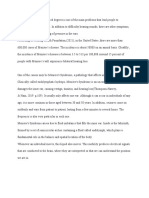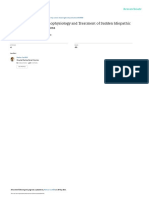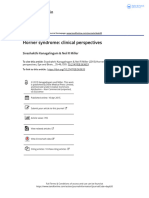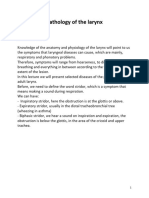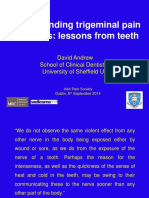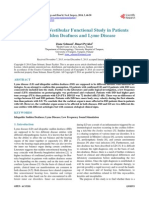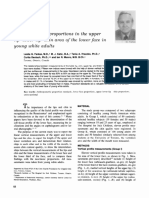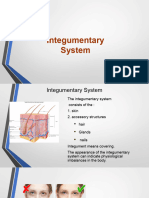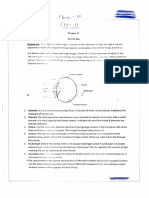THE EAR NOSE AND THROAT INSTITUTEOF
JOHANNESBURG
------------------------
Polyganglionitis Episodica (PGE)
The new concept for viral polyganglionitisof the head and neck
by
Herman Hamersma, M.B., Ch.B. (Pretoria), M.D. (Amsterdam)Otology and Neurotology,Florida, South Africa
A new concept called “Polyganglionitis Episodica (PGE)” was proposed by Dr Kedar Adour, chairman of the Cranial Nerve Research Clinic of the Kaiser Permanente Group in San Francisco, when he addressedotolaryngologists and neurologists in Bloemfontein, South Africa, on April 29, 1997. This new concept(syndrome) comprises a group of conditions with the same etiological mechanism, i.e. reactivation of viruses in the ganglia of cranial and/or spinal nerves.Dr Adour stated: I am here today to imply that herpes simplex is the great masquerader of our generationand the most frequent cause of acute cranial polyganglionitis. We used the term polyneuritis in the past,but have now changed to polyganglionitis, because with this term we can explain all the signs andsymptoms which occur. The disease is primarily in the ganglion, followed by a neuritis. Themucocutaneous manifestations are what we see, but this is only the lip of the volcano. The neuriticmanifestations are numerous and are seen by general practitioners as well as specialists, especiallyotolaryngologists, neurologists, dematologists, and internists. The multiple manifestations of herpessimplex reactivation are:
Vertigo, acute hearing loss, unilateral headache, unilateral fullness of the ear, unilateral tinnitus, lump in the throat, unilateral neck or tempero-mandibular joint pain, unexplained cough, tendency to recurrent attacks.
________________________________________________________
The Ear, Nose and Throat Institute of Johannesburg is a non-profit organisation founded by ear, nose and throat specialists. TheInstitute aims at developing the science, research and teaching of otorhinolaryngology and related areas, supplementary to other institutions in South Africa.
1
1
Pathophysiology of Herpes Simplex Reactivation
Approximately 80% of humans carry the herpes simplex virus in the ganglions of cranial and spinalnerves. Our discussion will be confined to the cranial nerves and Cervical 2 and 3. Once the virus getsinto the ganglion, it resides in the ganglion and waits there in a latent stage until it is reactivated and thencauses a ganglionitis. The virus then migrates down the nerve to cause mucocutaneous vesicles, and upthe nerve to cause a localized meningo-encephalitis at the brainstem
.
When the virus leaves the neural cell membrane, it takes up a coat of neurolipoprotien around it, and itdeposits that neurolipoprotein in the perineural compartment. This neurolipoprotein causes an immunemediated reaction, which causes demyelinization 8 - 10 days after the disease process has taken place.Therefore, when you see the mucocutaneous vesicle, this
is the lip of the volcano,
i.e. this superficialsign indicates what is going on deeper, i.e. inside the ganglion. Depending on which nerve the virus isreactivates in, signs and symptoms develop which have been described as various disease entities, e.g.Bell’s palsy, Ménière’s disease, etc.. Herpes simplex is the big masquerader. It causes the inflammatoryganglionitis, which then causes a viral induced immunological response, not autoimmune. In addition, ametabolic response is invoked by local changes, and the virus can also cause vasospasm. Fortunatelythese responses can be influenced by prednisone treatment, but unfortunately we do not have an antiviralagent to destroy the virus. We can only suppress its activity by means of acyclovir given in the acutestage. However, daily doses of acyclovir for long periods (up to one year) are already recommended tosuppress eruptions of genital herpes.Dr Adour continued: The structure of cranial ganglions need to be considered also. Ganglions containbipolar sensory cells and in the cranial nerves there is a relationship with motor and inhibitory fibres whichis unique. In the cranial nerves the motor and inhibitory fibres pass through the ganglion and any diseaseaffecting the sensory nuclei will also affect the motor and inhibitory fibres. Unlike the motor fibres in theperipheral systems (which are separated form the sensory ganglion), the motor fibres of the cranialnerves traverse the ganglion. So, any process which takes place inside the ganglion is going to affect themotor cells - they become involved as innocent bystanders. What people forget is that any sensorysystem has an inhibitory system, and those inhibitory fibres must traverse the ganglion. What happens if you have inhibitory systems like that which are affected? You are going to get a hyperactive state and wewill discuss that with every individual cranial nerve. That becomes very important - remember theinhibitory fibres.
2
2
Herpes Viral Replication (Sensory Ganglion) – Adour et al, 1997.
Background to the new concept
Today Bell’s palsy is still called ‘idiopathic facial palsy’. However, in 1919 a publication from Italy by Antoni reported that detailed clinical examination of patients with idiopathic facial palsy revealed that other nerves were often involved. Antoni named the condition “acute infectious polyneuritits cerebralisacusticofacialis”, thus indicating an infection as the causative agent. This report from Antoni wasrediscovered by Dr Adour and he then examined his Bell’s palsy patients more thoroughly. Already in1969 Dr Adour suggested that Bell’s palsy was a polyneuritits probably caused by reactivation of theherpes simplex virus. At that stage it was theory, but in 1996 Murakami et al (Japan) found the HSV-1genomes in the endoneural fluid from Bell’s palsy patients, who had deompression surgery performed.This was not found in patients with Ramsay Hunt syndrome (herpes zoster oticus) or in other controls. In 1952 both Furstenberg and Lempert suggested that idiopathic endolymphatic hydrops (Ménière’sdisease) had a viral etiology because the vertigo and hearing loss were often accompanied by burningsensation in the pharynx, earache, and numbness of the face. Schuknecht had already stated that theinner ear endolymphatic hydrops in Ménière’s disease could not explain the fluctuating low tone hearingloss which occurred in the early stages of the disease. In 1980 Adour and co-workers suggested thatMénière’s disease was a form of cranial polyganglionitis caused by reactivation of the herpes simplexvirus. They reported on other clinical findings which are sometimes present during a Ménière attack, e.g.pain deep inside the ear (due to glossopharyngeal nerve involvement). In 1997 Arnold and Niedermeyer reported the presence of HSV IgG in the perilymph of patients with Ménière’s disease, and concluded thatHSV may play an important role in the etiopathogenesis of Ménière’s disease.The proposal for this new syndrome of PGE originated from astute clinical observations. The clinicalsigns were there all the time but were not detected probably due to clinicians not paying enough attentionto the patient’s complaints. More detailed clinical examination of patients makes sense when they havethe conditions which will be described in the rest of this article.
3
3
Clinical Manifestations of PGE
The PGE conditions ascribed to Herpes Simplex-1 are Bell’s palsy, Ménière’s disease (idiopathicendolymphatic hydrops), vestibular neuritis, viral cochleitis, viral labyrinthitis, idiopathic sudden hearingloss, carotidynia, blocked ear without detectable abnormality, some cases of otalgia and pain in thethroat, hypersensitive scalp, dysphonia, tempero-mandibular joint syndrome (TMJ - also called Costensyndrome), and globus syndrome. A wellknown PGE condition due to the Varicella Zoster virus isRamsay Hunt syndrome (herpes zoster acustico-facialis).
Trigeminal NerveSensory branches:
The pain is due to inflammation of the nerve roots. Hypesthesia or numbness isdue to decreased function of the nerve endings. When inhibition is decreased a hypersensitivity to touchtakes place. The term ‘photophobia’ indicates intolerance to light, and ‘phonophobia’ indicatesintolerance to sound. A new term ‘somatophobia’ is proposed for intolerance to touch, and this is thesymptom of hypersensitivity to touch.
Motor branches:
When the masseter and pterygoid muscles are affected unilaterally, the jaw shifts tothe paralyzed side and there is clicking of the jaw joint. Along with the shift there is a ‘stuffy’ or ‘blockedear’ due to paralysis of the branches to the anterior belly of the M. tensor veli palatini, and the branches tothe M. tensor tympani which moves the ear drum - this used to be called ‘Costen syndrome’. So, if apatient complains of a stuffy ear and the examination shows no abnormality or hearing loss, check theother branches of the trigeminal nerve as well as other cranial nerves for involvement.
Facial Nerve
Motor branches:
The facial muscles, stapedius, buccinator, platysma, stylohyoid and digastric musclesare supplied.
Secretomotor fibres:
The salivary, lacrimal and nasal glands are supplied.
Special sensory fibres
provide taste to the anterior two thirds of the tongue (chorda tympani nerve).There are
no somatic sensory fibres
in the facial nerve trunk. Therefore Hunt’s zone of anesthesia of the auricle, or Hitselberger’s sign of anesthesia of the posterior aspect of the external ear canal, does notexist.In
Bell’s palsy
the paralysis of the muscles is due to the seventh nerve motor fibres being affected, thenumbness and pain in the cheek is due to trigeminal nerve involvement, the post auricular pain is due tothe 2nd Cervical nerve involvement. The taste disturbance (dysgeusia) is due to the chorda tympani cellbodies in the geniculate ganglion being involved. The hyperacusis, which is better called dysacousis or phonophobia, is not related to an absent stapedial reflex, but is a function of the cochlear division of the8th Cranial nerve (see later).
Vestibulo-cochlear nerve (Cr. VIII)
The vestibular and cochlear fibres are well known. Every sensory system has an inhibitory system alsoand the pathways of the inhibitory fibres of the cochlear nerve are not certain - it is thought that theypossibly pass through the olivo-cochlear bundle. Loss of inhibition will result in a complaint of loudnessintolerance (phonophobia), a common complaint of patients with Ménière’s disease.
Vertigo
can occur alone and is then called vestibular neuritis.
Acute hearing loss
which occurs alone is called idiopathic sudden sensorineural hearing loss or viral cochleitis.
Vertigo plus hearing loss
occurring once only is called labyrinthitis, and if it is episodic it is called Ménière’s diseaseor endolymphatic hydrops. However, the virus causes the disease initially (hearing and balance affected butreturning to normal after an episode), and the endolymphatic hydrops (chronic stage) is an end stage of the diseasedhearing and balance organs. Rather than individual diseases with individual pathophysiology, Dr Adour submittedthat the above diseases are a spectrum of the same process, i.e. viral inflammation, probably caused by herpessimplex reactivation.
4
4

























